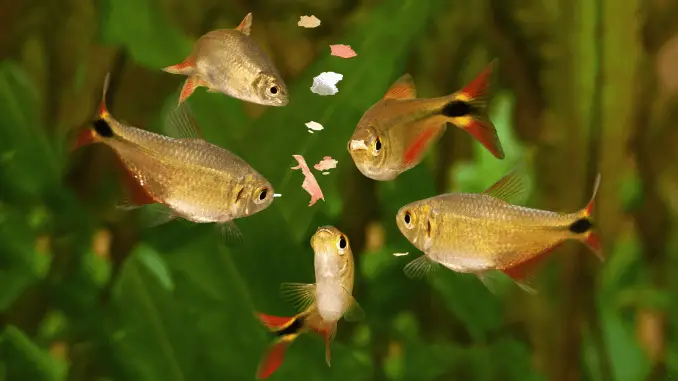
While shop-bought foods have plenty of nutrients and have been made to provide your fish with a good diet, they can be expensive and contain lots of chemicals and artificial ingredients.
Making your own fish food is a great way to give your fish a healthy diet and tailor the food to the exact dietary requirements of your fish.
Homemade fish food is cost-effective and perhaps a lot easier to make than you’re expecting.
The beauty of making your own fish food is that you can source all the products as sustainably as possible to ensure you are feeding your fish the best quality food.
Learn More With a Free eBook: Grab all 5 recipes here in an easy to read and printable format.
Where to Start
Now, all fish eat differently so it is difficult to provide you with an exact science for your fish food. All of the following recipes can be adapted to suit your fish.
We advise that you check out the ingredients list on your current fish food. You can then use that as a model when creating your own fish food.
Pick out the top three or four ingredients to begin with. They will most likely be fish ingredients such as Shrimp, Cod, and Salmon.
Remember you don’t have to stick to just one type of fish food, fish enjoy variety and are used to having a variety of foods in their natural habitats.
Why not make a few of these recipes and try them out? It’s likely your fish won’t like some of them, some fish can be quite picky eaters, but that’s fine. You can just try adding more or less of certain ingredients to find the sweet spot.
What Equipment Do I Need To Make Fish Food?
 To make the following recipes, you’ll need:
To make the following recipes, you’ll need:
- Your Ingredients
- A Good Quality Blender
- A Sharp Knife
- A Pan
- A Freezer
- Ice Cube Trays
Which Food is Right for Your Fish?
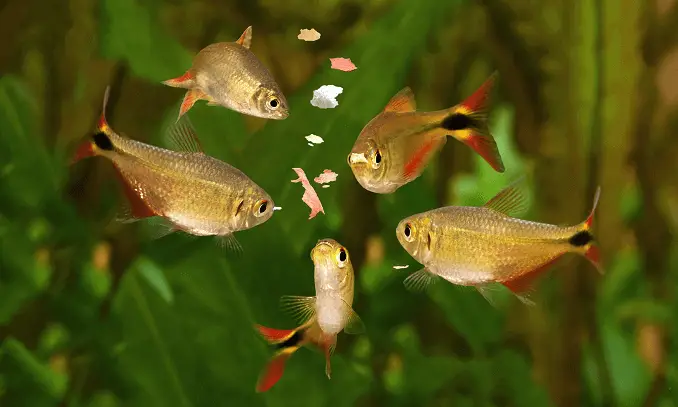 Not all fish food is suitable for all breeds of fish. Some fish are carnivores, some are herbivores and some are omnivorous. This is not a lifestyle choice; this is specific to their species.
Not all fish food is suitable for all breeds of fish. Some fish are carnivores, some are herbivores and some are omnivorous. This is not a lifestyle choice; this is specific to their species.
It’s important to understand which type of eater your fish is and consider the diet for your fish before you make fish food. Let’s take a quick look at each category.
Herbivores: Fish that only eat plants, are essential in maintaining a healthy ecosystem. Great at eating all the algae in your tank. Most Plecos are herbivores.
Omnivores: Fish that eat both plants and meat. The vast majority of fish are omnivores. Rainbow Sharks are omnivores.
Carnivores: Fish that only eat meat and other fish. An example is the Discus.
Plant food
Leafy greens are great for fish, they are full of minerals and vitamins and they are great mimics of natural plants that would be found in their habitats. Spinach, Kale, Seaweed, and Lettuce are some of the options available.
You can also get some great live water plants such as Cabomba, Egeria, and Limnophilla. All of which are commonly available in pet shops.
Fruit and Vegetables are also rich in nutrients.
You can feed your fish an assortment of them including apples, pears, broccoli, and peas. Some fruit and veg can be fed raw, but usually, you should steam or blanch them before putting them in your tank.
Fish also love garlic!
Garlic has plenty of anti-bacterial properties to keep your fish healthy. It can also increase your fish’s appetite. If it’s being used for this reason you should crush the garlic and just rub the juice/oil onto the food. Alternatively, you can mince it and add it to any homemade recipes.
Meat
A lot of fish species love eating fish. The most popular types of fish food include trout, salmon, tuna, and cod.
Earthworms are also a great addition to any homemade fish food recipe. They are packed full of nutrients and are very cheap.
You can also add other aquatic animals to your fish food, including brine shrimp, squid, mussels, and larvae.
You can get live, fresh, and frozen fish food. If you feed your fish live food, only allow them 5 minutes to eat it and then clear the rest out to prevent rotting.
A little bit of fat is ok for your fish, if your fish is a carnivore he can eat up to 6% concentration of fat, but don’t over-feed them with high-fat content foods as this can damage their liver.
DIY Fish Food Recipes
Let’s take a look at the recipes now.
Remember, they can all be adapted to suit your fish’s needs. You can add more or less of all of the ingredients. You may also want to add supplements and vitamins to the food.
1. Standard Homemade Gelatin Fish Food
This is perhaps the most common and easiest homemade fish food recipe. It’s quick and easy to make and can be stored in the freezer.
Ingredients:
- 2 Sachets of unsweetened gelatin
- 3 cups of Vegetables
- ½ Cup of Seafood
- ½ Clove of Garlic
- A drop of fish vitamins
Instructions:
Cut all the vegetables and cook them, you can either steam them or boil.
Puree the vegetables with the garlic and seafood until you have a mushy consistency and add the vitamins.
Boil water to make your gelatin and add the required amount (see the packet) then add the gelatin mix slowly to the vegetable mix.
To store, you can tip the mixture into ice cube trays or into thin baking sheets. Freeze until you need to use it.
2. Herbivore Fish Food
For the non-meat eaters in your tank. This recipe is perfect for plant-eaters.
Ingredients:
- Frozen Peas
- Spinach
- Cucumber
- Oats
- Unflavored gelatin
Instructions:
Blanch all the vegetables and then puree them until they are smooth (You can use whatever vegetables you have available).
Add in the oats.
In a separate bowl, mix the gelatin with hot water (see sachet for details) and then add the gelatin slowly to the vegetable mix.
Store in ice cube trays or larger muffin trays and shave a piece off as and when you need to feed your fish.
3. Meaty Fish Food
Full of protein and meat, this is the perfect food for the majority of fish species.
Ingredients:
- Any vegetables you have available (E.g. Broccoli, spinach, peas, carrots)
- Unflavored gelatin
- Beef heart
- White fish
- Shrimp
Instructions:
Cook the vegetables and blend to a smooth consistency.
Remove, shell, and blend the beef heart, white fish, and shrimp.
In a separate bowl mix the gelatin with hot water as per the sachet instructions.
Combine all the ingredients together and store them in ice cube trays in the freezer.
4. High Protein Fish Food
If you’re looking for a more specific recipe than you can follow rather than having to determine your own amounts, this recipe is great.
Ingredients:
- 200g of salmon (fresh or tinned seawater salmon)
- 1000g of raw shrimp (tail removed, unpeeled)
- 500g frozen peas
- 300g carrots
- 500g spinach
- 2 cloves of garlic
- Gelatin
Instructions:
Cut the salmon, shrimp, carrots, and spinach into pieces and blend them. If the mixture is too thick you can add a little water).
Mix your gelatin in a pan of 2L of hot water, and then add the rest of the ingredients to the pan.
Heat the mixture on low heat until everything is cooked through (30mins – 1hour).
Pour the mixture into small ice cube trays and use as needed.
5. No-Cook Fish Food Recipe
This easy-to-make recipe requires no cooking and can be made within 30 mins.
Ingredients:
- Spinach
- Peas
- Cucumber
- Shrimp
- Crab
- Cod
Instructions:
Chop all your ingredients into small pieces and blend. Add water if it’s too thick.
Make your gelatin mix in a separate container and add to the mix. Pour the mixture into ice cube trays and freeze.
Summary
Your frozen fish food will last for up to 12 months if stored properly in your freezer. Once the cubes are frozen, you can transfer them into a sealed bag or airtight container.
You can shave pieces of the ice cube to feed your fish, one ice cube is sufficient for a moderately stocked 50-gallon tank.
Remember when you’re introducing new foods you should also offer the food they are used to. Perhaps you could offer their regular food in the morning and the new food in the evening. If they take to the homemade food well you can switch over to that. You may want to alter the recipes every few months to give your fish plenty of variety.
We hope you have fun experimenting with different foods, I’m sure your fish would thank you if they could.
If you’ve learnt anything new in this article, or if you have any recipe suggestions for us, leave a comment below…

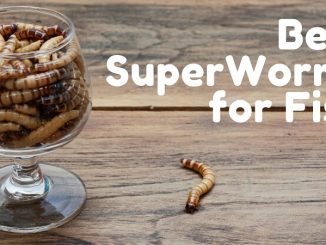
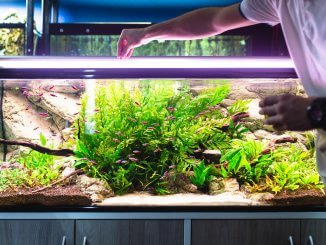
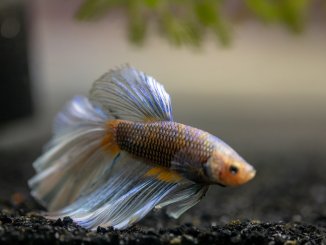
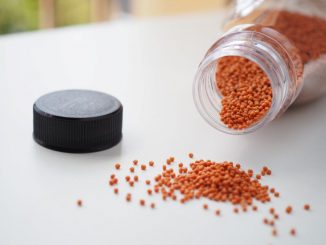
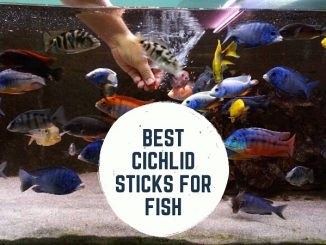
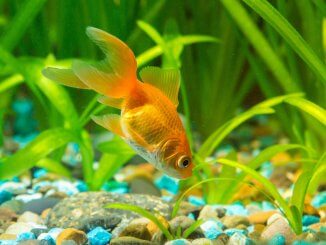
Do the meat products need to be cooked, or blended raw?
Hi Brianna, raw is best. Thanks, Robert
What are “fish vitamins?” in the general recipe? Where can I get them?
Hi Jess, there are plenty of vitamin supplements available at your local fish or online. If you feed them a well balanced diet you shouldn’t need to supplement their food. The main vitamins they require are Vitamin A, B-complex, C, D and K. Thanks, Robert
Can I feed my fish frozen spinach or does it have be boiled?
Hi Lovell, I would defrost it before you add it to the tank. Thanks, Robert
Not to be boiled
Do tropical fish have to have shrimp or fish in their food if I make homemade food 4 them?
Hi Pam, they don’t have to have it, if you’re feeding it to them as a treat. If this will be their main food though, you’ll need a source of protein. Thanks, Robert
Can I use chicken breast instead of shrimps or salmon?
Hi Ali, ideally you should use water based meats that they are likely to find in their natural habitats. Thanks, Robert
fish bone powder and vitamin can be also as the raw materials for fish feed
Ho
I have been making my own fish food a few times now and i was under the impression that it was cleaner for you tank but it is still cloudy after feeding the tank any ideas of why
Hi, it is ok to use tap water to make the gelatin? I have been trying to research online about homemade fish food, and I don’t see any warnings anywhere about the chlorine in tap water being used in the food…
how much meat? doesnt say how much we need
do you have a recipe for home made weekend (or longer) use food blocks